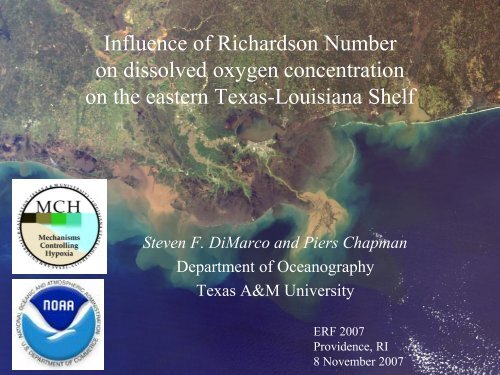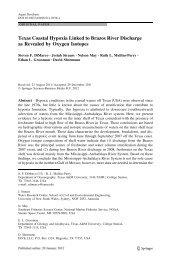influence of richardson number on dissolved oxygen concentration ...
influence of richardson number on dissolved oxygen concentration ...
influence of richardson number on dissolved oxygen concentration ...
You also want an ePaper? Increase the reach of your titles
YUMPU automatically turns print PDFs into web optimized ePapers that Google loves.
Influence <str<strong>on</strong>g>of</str<strong>on</strong>g> Richards<strong>on</strong> Number<br />
<strong>on</strong> <strong>dissolved</strong> <strong>oxygen</strong> c<strong>on</strong>centrati<strong>on</strong><br />
<strong>on</strong> the eastern Texas-Louisiana Shelf<br />
Steven F. DiMarco and Piers Chapman<br />
Department <str<strong>on</strong>g>of</str<strong>on</strong>g> Oceanography<br />
Texas A&M University<br />
ERF 2007<br />
Providence, RI<br />
8 November 2007
Outline<br />
• Objectives/methods/data<br />
• Case studies<br />
– Mid-summer: stable water column, persistent hypoxia<br />
– Late summer: erosi<strong>on</strong> <str<strong>on</strong>g>of</str<strong>on</strong>g> shoreward edge <str<strong>on</strong>g>of</str<strong>on</strong>g> hypoxia<br />
– Spring: variable stability, <strong>on</strong>set <str<strong>on</strong>g>of</str<strong>on</strong>g> depleted <strong>oxygen</strong> layer<br />
• C<strong>on</strong>clusi<strong>on</strong>s
Objectives<br />
• How do <strong>dissolved</strong> <strong>oxygen</strong> c<strong>on</strong>centrati<strong>on</strong>s<br />
vary <strong>on</strong> short (order <str<strong>on</strong>g>of</str<strong>on</strong>g> hours) time scales<br />
• How does this variability relate to changes<br />
in water column stability and current shear<br />
Management implicati<strong>on</strong>s: essential to sample at proper spatial and<br />
temporal scales to provide reas<strong>on</strong>able parameterizati<strong>on</strong>s for<br />
numerical modeling
Richards<strong>on</strong> Number (Ri)<br />
• Relates water column stability (stratificati<strong>on</strong>) to current<br />
shear<br />
– Stability metric: Brunt-Vaisala frequency (N 2 )<br />
– Current Shear: (∂u/∂z) 2<br />
– Ri = (N 2 ) / (∂u/∂z) 2<br />
– When shear is greater than stability -> mixing<br />
• Mixing Questi<strong>on</strong>s<br />
– Where<br />
– When<br />
– Strength<br />
– Relati<strong>on</strong> to DO c<strong>on</strong>centrati<strong>on</strong>
2007 Field Year<br />
• 3 MCH Cruises<br />
– March 22-29 (M8)<br />
– July 16-19 (M9)<br />
– September 6-9 (M10)<br />
• Mixing processes<br />
– 6 anchor stati<strong>on</strong>s (12-37 hours)<br />
– Velocity (RDCP)/CTD (Seabird 911) pr<str<strong>on</strong>g>of</str<strong>on</strong>g>iles
July 2007: M9 Cruise<br />
QuickTime and a<br />
TIFF (Uncompressed) decompressor<br />
are needed to see this picture.<br />
Mid-summer, stable water column<br />
Source: N. Rabalais LUMCON
Time Series Stati<strong>on</strong> D<br />
July 2007<br />
salinity<br />
• Well mixed surface<br />
layer<br />
• Str<strong>on</strong>g pynocline at<br />
~14 m depth<br />
• Thin (2 m) near<br />
bottom layer<br />
Salinity
Time Series Stati<strong>on</strong> D<br />
July 2007<br />
Dissolved <strong>oxygen</strong><br />
• Well mixed surface<br />
layer<br />
• Str<strong>on</strong>g oxycline at<br />
~14 m depth<br />
• Thin (2 m) near<br />
bottom hypoxic layer<br />
• Low variability<br />
Dissolved DO Oxygen
Time Series Stati<strong>on</strong> D<br />
July 2007<br />
Current speed<br />
• Low energy surface<br />
currents<br />
• Moderate current<br />
variability<br />
– ~15 m depth (3-5<br />
mab)<br />
– Above hypoxic<br />
layer<br />
speed
Time Series Stati<strong>on</strong> D<br />
July 2007<br />
Dissolved <strong>oxygen</strong> vs Ri<br />
• Mixing throughout water<br />
column above pycnocline<br />
– Mixing in surface layer<br />
• Low current shear<br />
• BUT high instability<br />
• Shear is enough to<br />
overcome water<br />
column stratificati<strong>on</strong><br />
– mid-water mixing above<br />
oxycline<br />
• Not affecting stable<br />
hypoxic layer<br />
• Weak mixing beneath<br />
oxycline<br />
• Stable hypoxic layer
September 2007: M10 Cruise<br />
Late summer: erosi<strong>on</strong> <str<strong>on</strong>g>of</str<strong>on</strong>g> shoreward edge
Time Series Stati<strong>on</strong> C<br />
6 September 2007<br />
Salinity<br />
• Weakly stratified<br />
– Early record<br />
– Low variability<br />
• Fresh water plume<br />
– Near surface<br />
– North wind<br />
• High frequency<br />
variability after<br />
plume event<br />
– Internal wave<br />
• Rise <str<strong>on</strong>g>of</str<strong>on</strong>g> deep<br />
isohalines<br />
Salinity
Time Series Stati<strong>on</strong> C<br />
6 September 2007<br />
Fluorometer<br />
• High surface fluorescence<br />
associated with plume event<br />
– Low nutrients<br />
• Patchy water column values<br />
– Occurs at same isopycnal<br />
layer<br />
• High near bottom<br />
fluorescence<br />
– High nutrients<br />
– Remineralizati<strong>on</strong><br />
Fluorometer
Time Series Stati<strong>on</strong> C<br />
6 September 2007<br />
Dissolved Oxygen C<strong>on</strong>centrati<strong>on</strong><br />
• Benthic source <str<strong>on</strong>g>of</str<strong>on</strong>g><br />
low DO<br />
• C<strong>on</strong>siderable<br />
temporal variability<br />
in lower layers<br />
• Suggests upward<br />
mixing <str<strong>on</strong>g>of</str<strong>on</strong>g> low DO<br />
Weakly stratified<br />
Str<strong>on</strong>ger stratificati<strong>on</strong>
Time Series Stati<strong>on</strong> C<br />
6 September 2007<br />
Velocity<br />
• Baroclinic structure<br />
– Two-layer<br />
– Semidiurnal<br />
• Surface and midwater<br />
velocity maxima<br />
– Up to 50 cm/s<br />
• High temporal variability<br />
• Shear throughout record
Time Series Stati<strong>on</strong> C<br />
6 September 2007<br />
DO and Ri<br />
• Surface mixing above<br />
pycnocline<br />
• Downward injecti<strong>on</strong><br />
events<br />
– 12 hours apart<br />
– Across pycnocline<br />
• Mixing at upper edge <str<strong>on</strong>g>of</str<strong>on</strong>g><br />
low DO<br />
– Erosi<strong>on</strong> <str<strong>on</strong>g>of</str<strong>on</strong>g> upper edge <str<strong>on</strong>g>of</str<strong>on</strong>g><br />
oxycline
March 2007: M8 Cruise<br />
C<br />
Fr<strong>on</strong>tal passage case
Time Series Stati<strong>on</strong> C<br />
March 2007<br />
Salinity<br />
Fresh<br />
Salty<br />
• 24 hours<br />
• Weakly Stratified<br />
– Beginning <str<strong>on</strong>g>of</str<strong>on</strong>g><br />
record<br />
• Current/wind shift<br />
• Rising halocline<br />
• Str<strong>on</strong>gly stratified<br />
– mid to end <str<strong>on</strong>g>of</str<strong>on</strong>g><br />
record
Time Series Stati<strong>on</strong> C<br />
March 2007<br />
Dissolved Oxygen C<strong>on</strong>centrati<strong>on</strong> (ml/l)<br />
• Oxygenated surface<br />
waters<br />
• Oxygen depleted<br />
near-bottom water<br />
• Complex vertical<br />
structure<br />
• DO falls under<br />
str<strong>on</strong>ger pycnocline
Time Series Stati<strong>on</strong> C<br />
March 2007<br />
Dissolved Oxygen vs Ri<br />
• Surface mixing<br />
– Throughout record<br />
• Subpycnocline mixing<br />
– Increases in sec<strong>on</strong>d half<br />
<str<strong>on</strong>g>of</str<strong>on</strong>g> record<br />
• Mid-water column<br />
– Pre-fr<strong>on</strong>t<br />
• Mixing al<strong>on</strong>g upper<br />
edge <str<strong>on</strong>g>of</str<strong>on</strong>g> pycnocline<br />
– Hour 9<br />
• upward mixing <str<strong>on</strong>g>of</str<strong>on</strong>g> low<br />
DO near-bottom water<br />
– Hour 16<br />
• Str<strong>on</strong>g vertical mixing<br />
• Pycnocline at 6 m<br />
• Downward mixing <str<strong>on</strong>g>of</str<strong>on</strong>g><br />
larger DO upper<br />
waters
C<strong>on</strong>clusi<strong>on</strong>s<br />
• Eastern TX-LA shelf has a variety <str<strong>on</strong>g>of</str<strong>on</strong>g> physical processes<br />
that can affect stratificati<strong>on</strong> (freshwater input, wind<br />
forcing, internal waves) and complex vertical current<br />
structure<br />
• Temporal variability <str<strong>on</strong>g>of</str<strong>on</strong>g> stratificati<strong>on</strong>, current structure, and<br />
<strong>dissolved</strong> <strong>oxygen</strong> c<strong>on</strong>centrati<strong>on</strong> can be <strong>on</strong> the order <str<strong>on</strong>g>of</str<strong>on</strong>g><br />
hours<br />
• Vertical current structure combined with water column<br />
stability c<strong>on</strong>trols vertical mixing<br />
• Mixing c<strong>on</strong>tributes to c<strong>on</strong>trol <str<strong>on</strong>g>of</str<strong>on</strong>g> temporal variability <str<strong>on</strong>g>of</str<strong>on</strong>g> DO
Acknowledgements<br />
• This work was funded by NOAA CSCOR under<br />
NGOMEX-2006.<br />
• Data processing: Dr M. K. Howard (TAMU).<br />
• Thanks to the crew <str<strong>on</strong>g>of</str<strong>on</strong>g> the R/V Pelican.<br />
• Special thanks to scientists/students who participated <strong>on</strong><br />
the cruises.



